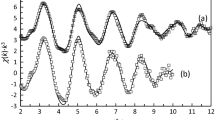Summary
Kinetic results for reaction of the title complex with oxalate ion have been reinterpreted in terms of a simple dissociative mechanism in which loss of ligand is rate determining. Competition between the ligand and oxalate ion for the dissociated reactive intermediate causes the observed rate constant to rise to a limiting value with increasing oxalate ion concentration. This rate limit is equal to the rate of dissociation. In agreement with this mechanism, rate constants for reaction of four other related iron(II) complexes with an excess of a range of poly carboxylates were found to be similar to their respective rates of aquation, so demonstrating that polycarboxylares act as scavengers rather than nucleophiles in these reactions.
Similar content being viewed by others
References
J. Burgess Ed.,Inorganic Reaction Mechanisms, Chem. Soc. Specialist Periodical Report, London,1, 176 (1971);2, 168 (1972).
D. W. Margerum,J. Am. Chem. Soc., 79, 2728 (1957);
D. W. Margerum and L. P, Morgenthaler,J. Am. Chem. Soc., 84, 706 (1962); (c) J. Burgess,Inorg. Chim. Acta, 5, 133 (1971).
J. Burgess, G. F. Ellis, D. J. Evans, A. Porter, R. Wane, and R. D, Wyvill,J. Chem. Soc. A, 44 (1971) 536; (b) D. J. Farrington, J, G. Jones, and M. V, Twigg,J. Chem. Soc. Dalton Trans., to be submitted;Inorg. Chim. Acta, 25, L 75 (1977). See also ref. 2b; (c) R. D. Gillard, Coord. Chem. Rev., 16, 67 (1975).
V. V. S. E. Dutt and Fi, A. Mottola,Anal. Cheat, 49 319 (1977); this reaction is the basis of an improvement to a novel flow system for the rapid routine determination of iron, viz. V. V. S. E. Dutt, A. E. Hanna, and H. A. Mottola, Anal. Chem., 48, 1207 ( 1976).
Formation of Felll oxalate species in the presence of excess oxalate is the driving force for this reaction. Similarly, oxygen is necessary for reaction of [Fe(phen)3]2 with HO−. The final product is “ferric hydroxide”: G. Nord and T. Pizzino,Chem. Comm.., 1633 (1970).
E. R. Gardner, F. M. Mekhail, J. Burgess, and J. M. Rankin,J. Chem. Soc. Dalton Trans., 1340 (1973).
M. V. Twigg,Inorg. Chim. Acta, 10, 17 (1974).
Assuming that k2/(k1−1) + k,) ≈ 0.25 (ie. similar to that for 1 Pe(bipy)312+ (ref 7), values of ca. 14 x 10−3 s−1 and ca. 8 x 10−4 s−1 can be estimated for k ( at 58° and 35° respectively.
Log (j3 = 21.2. for I Pr(phen)3121 H. loving and D. H, Mellor, J. Chem. Soc., 5222 (1962)l, of log β3 = 17.8 for [Fe(5NO2 phen)3]2+ (C:. J. Hawkins, H, Ducwell, and W. Iv. Pickering, Analw. Chim. Acta, 25, 257 (1961)) and log β3 = 17,1 for IFe(bipy)312+1J. 11, Baxendale and P. George, Trans. Faraday' Soc'., 46, 55 (1950)l.
I. R. Gardner, F. M. Mekhail, and J. Burgess,Internat. J. Chem. Kinetics, 6, 133 (1974).
The concentration of 2,2′-bipyridyl would be ca. 2 x 10−1 mol f-1in this strong salt solution 111. P. Bennetto and J.. W. Letchcr, Chem. led,. 847 (1972); N. P. Komar and G. S. '. Zaslavskaya, Ross. 1, Phys. Chem. 47, 1642 (1973)l; of the initial concentration of I Fe(bipy)312+, approximately 10−4 mol l-1 in these experiments. (12) D, J. Farrington and J. G. Joncs, Inorg. Chim. Acta. 6, 575 (1972).
Author information
Authors and Affiliations
Rights and permissions
About this article
Cite this article
Burgess, J., Twigg, M.V. On the reaction of oxalate ion withtris-3-(2-Pyridyl)-5, 6-bis-(4-sulphophenyl)-1,2,4-triazine iron (11) in aqueous solution: Kinetics of dissociation of low-spin iron(II) complexes in the presence of polycarboxylate ions. Transition Met Chem 3, 88–90 (1978). https://doi.org/10.1007/BF01393516
Received:
Issue Date:
DOI: https://doi.org/10.1007/BF01393516



